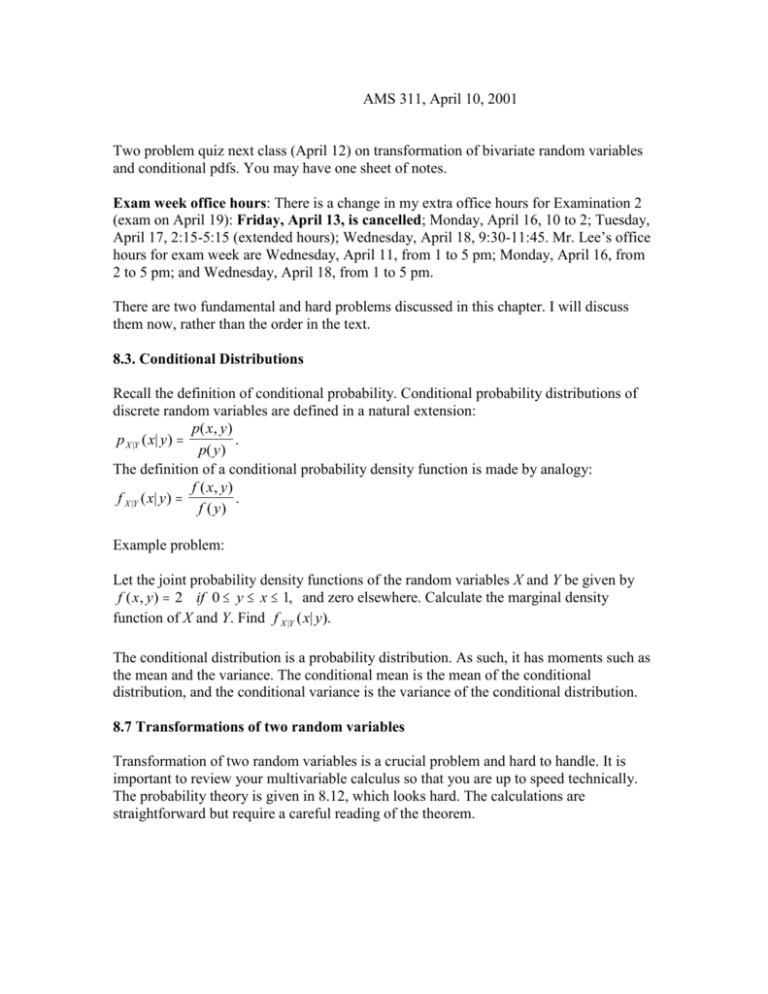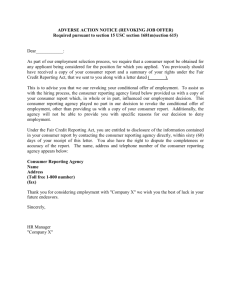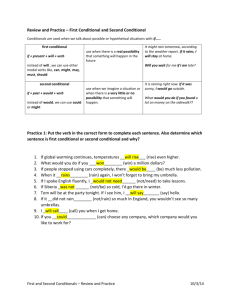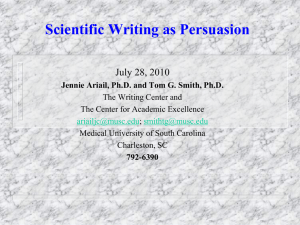Lecture 18
advertisement

AMS 311, April 10, 2001 Two problem quiz next class (April 12) on transformation of bivariate random variables and conditional pdfs. You may have one sheet of notes. Exam week office hours: There is a change in my extra office hours for Examination 2 (exam on April 19): Friday, April 13, is cancelled; Monday, April 16, 10 to 2; Tuesday, April 17, 2:15-5:15 (extended hours); Wednesday, April 18, 9:30-11:45. Mr. Lee’s office hours for exam week are Wednesday, April 11, from 1 to 5 pm; Monday, April 16, from 2 to 5 pm; and Wednesday, April 18, from 1 to 5 pm. There are two fundamental and hard problems discussed in this chapter. I will discuss them now, rather than the order in the text. 8.3. Conditional Distributions Recall the definition of conditional probability. Conditional probability distributions of discrete random variables are defined in a natural extension: p( x , y ) p X |Y ( x| y) . p( y ) The definition of a conditional probability density function is made by analogy: f ( x, y) f X |Y ( x| y) . f ( y) Example problem: Let the joint probability density functions of the random variables X and Y be given by f ( x, y) 2 if 0 y x 1, and zero elsewhere. Calculate the marginal density function of X and Y. Find f X |Y ( x| y). The conditional distribution is a probability distribution. As such, it has moments such as the mean and the variance. The conditional mean is the mean of the conditional distribution, and the conditional variance is the variance of the conditional distribution. 8.7 Transformations of two random variables Transformation of two random variables is a crucial problem and hard to handle. It is important to review your multivariable calculus so that you are up to speed technically. The probability theory is given in 8.12, which looks hard. The calculations are straightforward but require a careful reading of the theorem. Steps to transforming two random variables: 1. Confirm that the transformation new1 h1 (old1 , old 2 ) and new2 h2 (old1 , old 2 ) is one-to-one. The theory generalizes for many-to-one transformations, but these problems are beyond the level of this course. 2. Find the inverse transformation. That is, solve for the old variables in terms of the new variables: old1 w1 (new1 , new2 ) and old 2 w2 (new1 , new2 ) . 3. Define the region in which the joint pdf is greater than zero for the new variables. This is crucial for specifying the range of the new variables. 4. Calculate the Jacobian of the transformation. This is the determinant of the following matrix: old1 old1 new1 new2 old 2 old 2 new1 new2 Note the pattern. Take the absolute value of the Jacobian (make it positive!). 5. In the joint pdf of the old variables, insert the solution for the old variables. 6. Multiply by the absolute value of the Jacobian. 7. Make sure that you have specified the range for the new variables. Consider the following example problem: Let X and Y be independent random variables with common probability density function f ( x) e x , x 0, and zero otherwise. Find the joint probability density function of U=X+Y and V=X-Y. Sometimes, one is interested in only one of the new variables. One then finds the marginal pdf of that new variable. In this event, you should check whether a direct calculation of the cdf of the new variable is easier.







